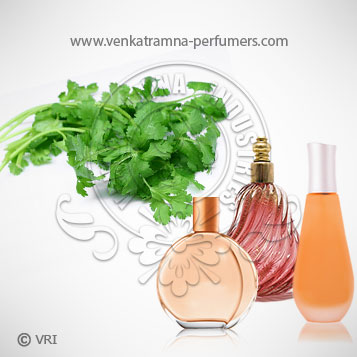
| Botanical Name | Corriandrum sativum |
| Common Name | Coriander , Chinese parsley, cilantro |
| Country of Origin | India |
| Solubility | Insoluble in water, soluble in alcohol and oils |
| Specific Gravity | 0.8769 @ 72°F |
| Optical Rotation | 8.77 |
| Refrective Index | 1.464 @ 72°F |
| PlantPart | Seeds |
| Bland With | Coriander Oil blends particularly well with Bergamot, Cinnamon, Ginger, Grapefruit, Lemon, Neroli and Orange. |
| CAS No | 8008-52-4 |
| Flash Point | 91°C |
| Extraction Method | Steam Distilled |
Coriander (Coriandrum sativum L.) is a plant from the family of Apiaceae. Seeds and the herb of coriander, both of which are used as spice or a medicinal plant. It contains flavoring compounds such as linalool, geraniol, pinen, limonene, geranylacetat, terpinen, and borneol. It is broadly cultivated in various environments around the globe. In general, coriander falls into two major categories based on fruit size. This ultimately determines its oil content and use.
The Egyptians used Coriander Seeds as an aphrodisiac, and they were found in the tomb of Tutankhamen; the Romans and Greeks used the seeds to flavour their wines; and in India, the seeds are still used for cooking. The Benedictine monks documented using them in 1510 as an ingredient in their herbal tonic known as Benedictine. The Carthusian Monks used them to make Chartreuse in the 1740's, and the Carmelite order in France used Coriander Seeds as an ingredient with lemon balm, lemon zest, angelica root and nutmeg in their 17th century eau de toilette known as Carmelite Waters. India is the biggest producer, consumer and exporter of coriander in the world with an annual production of around three lakh tonnes. It is an annual, herbaceous plant which originated from the Mediterranean and Middle Eastern regions and known as medicinal plants. It contains an essential oil (0.03 to 2.6%) (Nadeem et al., 2013). All parts of this herb are in use as flavoring agent and/or as traditional remedies for the treatment of different disorders in the folk medicine systems of different civilizations (Sahib et al., 2012). Coriander closely resembles flat leaf parsley. This resemblance makes many people confused between the two however, coriander has strong fragrance and parsley has mild fragrance. It grows best in dry climates however it can grow in any type of soil like light, well drained, moist, loamy soil, and light to heavy black soil (Verma et al., 2011). Its seeds are almost ovate, globular and have a mild, sweet, slight pungent like citrus flavor with a hint of sage. The most important constituents of its seeds are the essential oil and fatty oil
Color : Light yellow transparent liquid @22C with sweet-woody with a candy like odor,
Aroma : Sweet, spicy, slightly fruity, herbaceous warm smell
Decanal (E)-2-decenal linalool 2-decen-1-ol (E)-2-dodecenal (E)-2-tetradecenal (E)-2-undecenal Decanol Nonane Dodecanal Tridecanal
Coriander nutrition is basically due to its green leaves and dried fruits. Like all other green leafy vegetables, its leaves are a rich source of vitamins, minerals and iron. Its leaves contain high amount of vitamin A (β-carotene) and vitamin C. The green herbs contain vitamin C upto 160 mg/100 g and vitamin A upto 12 mg/100 g (Girenko, 1982). It is very low in saturated fat and cholesterol and a very good source of thiamine, zinc and dietary fiber. Green coriander contains 84% water. Besides nutritional benefits, it is well known for its health or medicinal benefits as well as for additional benefits like it acts as antimicrobial agent. The type of meat and temperature did not influence the antimicrobial activity of the oil; indicating the potential of coriander oil to serve as a natural antimicrobial compound against Campylobacter jejuni in food (Rattanachaikunsopon and Phumkhachorn, 2010). The most important and well characterized functional aspect involves antioxidant activity Essence of Coriander Essential Oil Coriander oil has distinct applications in kitchen to add flavors in recipes. The plant seeds, leaves and roots are edible, although they have very distinct flavors and uses. The herb has a light and fresh flavor. Coriander can be used as whole plant and can be processed because of its perishable nature of leaves and to increase the palatability of ripe fruits (seeds) before using it as flavoring agent in different food preparations. Whole plant of coriander mainly fresh leaves and ripe fruits are used for culinary purposes. Coriander leaves have different taste than its seeds, with citrus overtones. It promotes digestion, gives relaxation and on the top is used for skin purposes. Due to its unique taste and smell, it possesses some medicinal properties as well. Further, the oil can be consumed to produce healthy cholesterol in the body. COMMON USAGE • Helps in weight loss • Increase libido • Reduces gas problems • Treats spasms • Works as deodorant • Purifies blood • Eliminates body pain • Promotes hormonal secretion • Prevents fungal infection